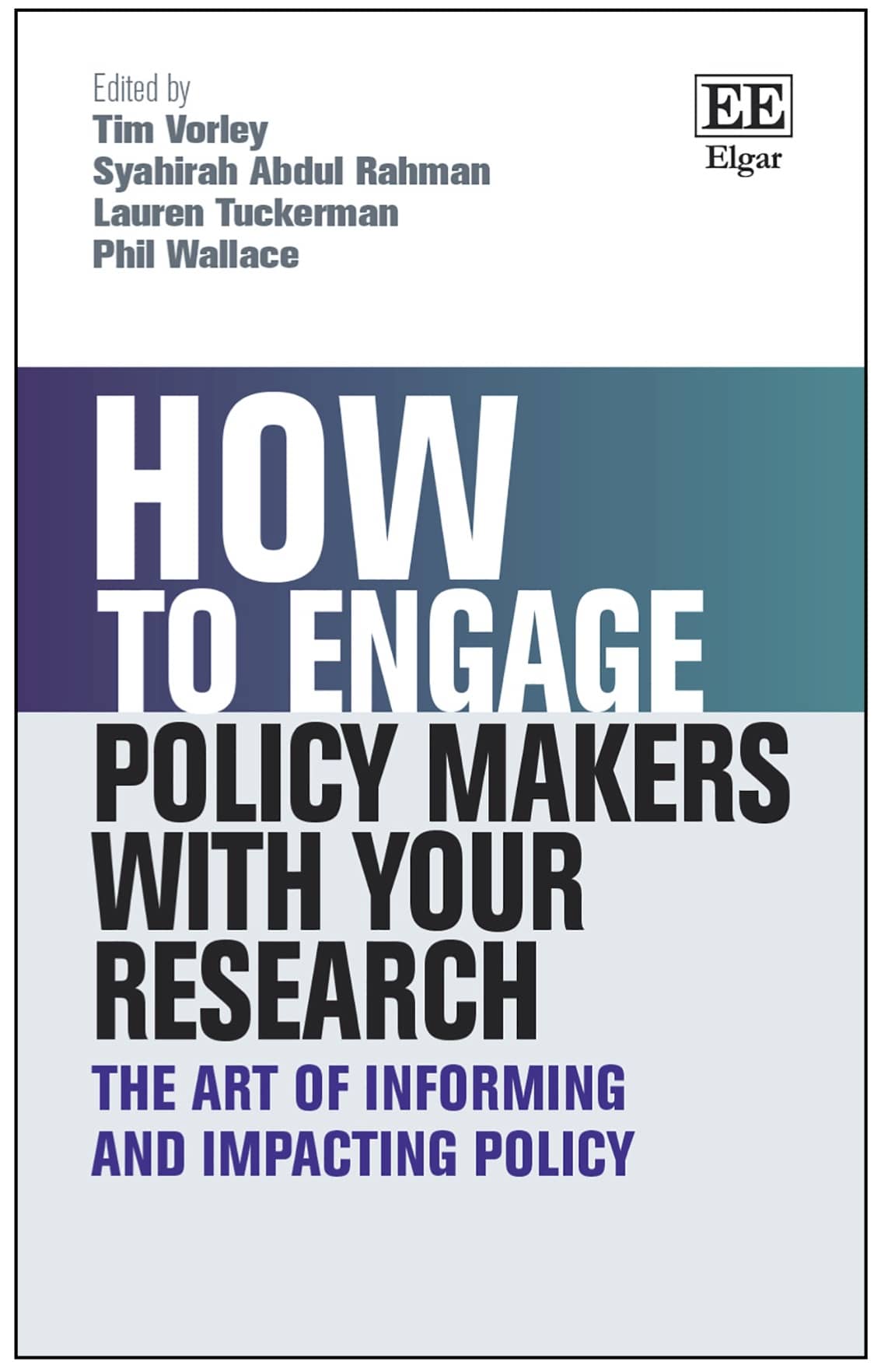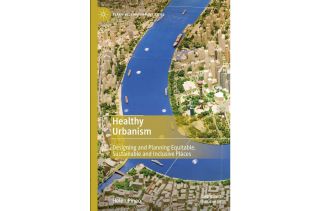
www.buildingsandcities.org/insights/reviews/engage-policy-makers.html
How to Engage Policy Makers with Your Research: The Art of Informing and Impacting Policy
Edited by: Tim Vorley, Syahirah Abdul Rahman, Lauren Tuckerman, Phil Wallace. Edward Elgar Publishing, 2022, ISBN: 978 1 80037 895 7
Richard Simmons (University College London) applauds this excellent book that chronicles the successes, failures and investigations of a wide range of academics to distil sound and practical advice on how evidence can be best communicated to get research findings into realpolitik. This book is a must read for every researcher who wants their work to reach policymakers.

In 1999, UK Prime Minister Tony Blair launched his 'Modernising Government' initiative, demanding evidence-based policy making. In 2023, many believe his reputation remains tarnished by his decision to invade Iraq in 2003 in pursuit of weapons of mass destruction, for which, it turned out, there was no evidence. Should we be surprised?
Studies of whether politicians and public servants take evidence into account before making decisions tend to answer: 'sometimes'. It is natural that data agreeing with the ruling political ideology or supporting manifesto commitments are likely to get more airtime. Yet policy does not usually appear out of thin air. When it does, it is difficult to deliver. Even the greatest ideologue or populist needs to know what problems to address and what might give traction over them. Prejudices can be evidence too: policymakers need to understand them. Inevitably, evidence is important in the mix when developing policy and measuring its impact.
Then the questions are: Where is the evidence? How trustworthy is it? How easy is it to digest? Does it lead to practical applications? Does it tell us what works? Academia is one obvious place to ask but, as the authors of what should be an essential companion for academic researchers point out, there are obstacles to getting research findings out of universities and institutes and into realpolitik.
It is those obstacles this book will help overcome. It is thorough, comprehensive and digestible. Much wisdom and experience are distilled into punchy, well-structured and practical articles that will save researchers time and energy. There are useful pull-outs with top tips and good examples, as well as thorough but readable in-depth analyses of research and case studies, illustrating how best to steer a course through the tricky waters of UK national and local government policy creation. Examples include (though are not limited to) how to take advantage of the UK Parliamentary Office of Science and Technology's Fellowship programme for PhD students (Rose & Tyler, 'The value of research evidence for policy', p. 33); how to find a shared language with non-specialists (Foxen & Bermingham, 'Speaking a Shared Language', Ch. 4); embedding researchers in policymaking environments (Hill et al., 'Co-producing policy relevant research', p. 80), how to work as a critical friend (something close to this author's experience) (Johnson et al., 'Critical Friends - real time insights for shaping strategy', Ch. 10); and the challenges of establishing a place-based research institute, which the UK fails at more than it succeeds but which has proved its value abroad (Riley et al., 'The City-Region Economic Development Institute - establishing a successful place-based research institute to support regions in turbulent times and beyond', Ch. 19). Many more good examples can be found in the book.
These waters are hard to navigate. Just working out where to make an input and whose attention to seek is difficult. A great strength of the book is the breadth of its advice, which draws on the successes, failures and investigations of a wide range of academics (including post-grads) over the full span of disciplines. It is hard to think of any stone left unturned. From direct contracting with ministries, through sponsored research programmes, via partnerships with devolved bodies and think tanks, to influencing by other means, the authors offer sound, practical advice.
Perhaps the only area left for exploration is how research might be used to inform future policy makers while they undertake their first degrees. Learning about actual investigations that demonstrate the uses and value of research should help create clients knowledgeable in how to direct policy founded in real-world precepts, not just theory and ideology.
This book should be on the tablet, workbench or desk of every researcher who wants their work to do more than gather virtual dust in an online archive.
Latest Peer-Reviewed Journal Content
A framework for 1.5°C-aligned GHG budgets in architecture
G Betti, I Spaar, D Bachmann, A Jerosch-Herold, E Kühner, R Yang, K Avhad & S Sinning
Net zero retrofit of the building stock [editorial]
D Godoy-Shimizu & P Steadman
Co-learning in living labs: nurturing civic agency and resilience
A Belfield
The importance of multi-roles and code-switching in living labs
H Noller & A Tarik
Researchers’ shifting roles in living labs for knowledge co-production
C-C Dobre & G Faldi
Increasing civic resilience in urban living labs: city authorities’ roles
E Alatalo, M Laine & M Kyrönviita
Co-curation as civic practice in community engagement
Z Li, M Sunikka-Blank, R Purohit & F Samuel
Preserving buildings: emission reductions from circular economy strategies in Austria
N Alaux, V Kulmer, J Vogel & A Passer
Urban living labs: relationality between institutions and local circularity
P Palo, M Adelfio, J Lundin & E Brandão
Living labs: epistemic modelling, temporariness and land value
J Clossick, T Khonsari & U Steven
Co-creating interventions to prevent mosquito-borne disease transmission in hospitals
O Sloan Wood, E Lupenza, D M Agnello, J B Knudsen, M Msellem, K L Schiøler & F Saleh
Circularity at the neighbourhood scale: co-creative living lab lessons
J Honsa, A Versele, T Van de Kerckhove & C Piccardo
Positive energy districts and energy communities: how living labs create value
E Malakhatka, O Shafqat, A Sandoff & L Thuvander
Built environment governance and professionalism: the end of laissez-faire (again)
S Foxell
Co-creating justice in housing energy transitions through energy living labs
D Ricci, C Leiwakabessy, S van Wieringen, P de Koning & T Konstantinou
HVAC characterisation of existing Canadian buildings for decarbonisation retrofit identification
J Adebisi & J J McArthur
Simulation and the building performance gap [editorial]
M Donn
Developing criteria for effective building-sector commitments in nationally determined contributions
P Graham, K McFarlane & M Taheri
Reimagining circularity: actions for optimising the use of existing buildings
R Lundgren, R Kyrö, S Toivonen & L Tähtinen
Effective interdisciplinary stakeholder engagement in net zero building design
S Vakeva-Baird, F Tahmasebi, JJ Williams & D Mumovic
Metrics for building component disassembly potential: a practical framework
H Järvelä, A Lehto, T Pirilä & M Kuittinen
The unfitness of dwellings: why spatial and conceptual boundaries matter
E Nisonen, D Milián Bernal & S Pelsmakers
Environmental variables and air quality: implications for planning and public health
H Itzhak-Ben-Shalom, T Saroglou, V Multanen, A Vanunu, A Karnieli, D Katoshevski, N Davidovitch & I A Meir
Exploring diverse drivers behind hybrid heating solutions
S Kilpeläinen, S Pelsmakers, R Castaño-Rosa & M-S Miettinen
Urban rooms and the expanded ecology of urban living labs
E Akbil & C Butterworth
Living with extreme heat: perceptions and experiences
L King & C Demski
A systemic decision-making model for energy retrofits
C Schünemann, M Dshemuchadse & S Scherbaum
Modelling site-specific outdoor temperature for buildings in urban environments
K Cebrat, J Narożny, M Baborska-Narożny & M Smektała
Understanding shading through home-use experience, measurement and modelling
M Baborska-Narożny, K Bandurski, & M Grudzińska
Building performance simulation for sensemaking in architectural pedagogy
M Bohm
Beyond the building: governance challenges in social housing retrofit
H Charles
Heat stress in social housing districts: tree cover–built form interaction
C Lopez-Ordoñez, E Garcia-Nevado, H Coch & M Morganti
An observational analysis of shade-related pedestrian activity
M Levenson, D Pearlmutter & O Aleksandrowicz
Learning to sail a building: a people-first approach to retrofit
B Bordass, R Pender, K Steele & A Graham
Market transformations: gas conversion as a blueprint for net zero retrofit
A Gillich
Resistance against zero-emission neighbourhood infrastructuring: key lessons from Norway
T Berker & R Woods
Megatrends and weak signals shaping future real estate
S Toivonen
A strategic niche management framework to scale deep energy retrofits
T H King & M Jemtrud
Generative AI: reconfiguring supervision and doctoral research
P Boyd & D Harding
Exploring interactions between shading and view using visual difference prediction
S Wasilewski & M Andersen
How urban green infrastructure contributes to carbon neutrality [briefing note]
R Hautamäki, L Kulmala, M Ariluoma & L Järvi
Implementing and operating net zero buildings in South Africa
R Terblanche, C May & J Steward
Quantifying inter-dwelling air exchanges during fan pressurisation tests
D Glew, F Thomas, D Miles-Shenton & J Parker
Western Asian and Northern African residential building stocks: archetype analysis
S Akin, A Eghbali, C Nwagwu & E Hertwich
Join Our Community

The most important part of any journal is our people – readers, authors, reviewers, editorial board members and editors. You are cordially invited to join our community by joining our mailing list. We send out occasional emails about the journal – calls for papers, special issues, events and more.
We will not share your email with third parties. Read more



Latest Commentaries
COP30 Report
Matti Kuittinen (Aalto University) reflects on his experience of attending the 2025 UN Conference of the Parties in Belém, Brazil. The roadmaps and commitments failed to deliver the objectives of the 2025 Paris Agreement. However, 2 countries - Japan and Senegal - announced they are creating roadmaps to decarbonise their buildings. An international group of government ministers put housing on the agenda - specifying the need for reduced carbon and energy use along with affordability, quality and climate resilience.
Building-Related Research: New Context, New Challenges
Raymond J. Cole (University of British Columbia) reflects on the key challenges raised in the 34 commissioned essays for Buildings & Cities 5th anniversary. Not only are key research issues identified, but the consequences of changing contexts for conducting research and tailoring its influence on society are highlighted as key areas of action.